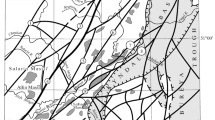Abstract.
New U-Pb single-zircon geochronology undertaken on tonalitic gneisses, granite sheets, migmatites and metasediments from the Lewisian Gneiss Complex on the mainland and the northern part of the Outer Hebrides, NW Scotland, have been used to test the correlation of so-called Laxfordian events across the complex from the Outer Hebrides to the mainland, and the current model for the evolution of the complex as a whole. The study has revealed that the granite sheets originated in two quite different melting events. Those on the mainland at Loch Laxford are ca. 1,855 Ma old whereas those on Harris and Lewis, with which they are presently correlated, are ca. 1,675 Ma old. Grey gneisses associated with granites on the south side of Loch Laxford are confirmed to belong to the 'northern region'. A migmatitic grey gneiss on Harris has given a protolith age of ca. 3,125 Ma, the currently oldest recognised in the complex. Detrital zircons in the Leverburgh and Langavat belts range in age from 2,780 to 1,880 Ma and unequivocally demonstrate deposition in the Palaeoproterozoic. The granulite facies metamorphism in this block is dated from zircon overgrowths at ca. 1,880 Ma. The Laxford Shear Zone which separates the northern and central regions is interpreted to have evolved post-1,860 Ma, during amphibolite facies metamorphism accompanying deformation which took place at ca. 1,740 Ma in both regions. On Harris, the Langavat-Finsbay shear zone developed after 1,675 Ma when a ca. 1,880-Ma granulite facies Proterozoic arc was juxtaposed against amphibolite facies Archaean rocks to the north. Therefore, the shear zones which bound tectonic blocks in the Lewisian Complex evolved at different times and can be interpreted as terrane boundaries. The new data confirm that the Lewisian Complex was not constructed from one contiguous piece of Archaean crust reworked in the Proterozoic but was progressively assembled from several discrete terranes during the Proterozoic. Accordingly, the former regional divisions of the Lewisian Complex are here renamed as follows. On the mainland, the northern region is called the Rhiconich terrane, and the central region the Assynt terrane. On the Outer Hebrides, the Archaean gneisses of Lewis and the northern part of Harris comprise the Tarbert terrane, whereas the newly accreted Proterozoic blocks are called the Roineabhal terrane in Harris and the Niss terrane in the north on Lewis. Wider correlations show that the geology of the Outer Hebrides has more in common with East Greenland than mainland Scotland on the eastern side of the Minch Fault.
Similar content being viewed by others
Author information
Authors and Affiliations
Additional information
Electronic Publication
Rights and permissions
About this article
Cite this article
Friend, .C., Kinny, .P. A reappraisal of the Lewisian Gneiss Complex: geochronological evidence for its tectonic assembly from disparate terranes in the Proterozoic. Contrib Mineral Petrol 142, 198–218 (2001). https://doi.org/10.1007/s004100100283
Received:
Accepted:
Issue Date:
DOI: https://doi.org/10.1007/s004100100283



